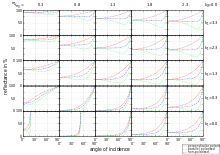Reflectivity
Reflectivity or reflectance is the fraction of incident electromagnetic power that is reflected at an interface, in contrast to the reflection coefficient, which is the ratio of the reflected to incident electric field.[1]
Reflectance

The reflectance or reflectivity is the square of the magnitude of the reflection coefficient.[2] The reflection coefficient can be expressed as a complex number as determined by the Fresnel equations for a single layer, whereas the reflectance (or reflectivity) is always a positive real number.
According to the CIE (the International Commission on Illumination),[3] reflectivity is distinguished from reflectance by the fact that reflectivity is a value that applies to thick reflecting objects.[4] When reflection occurs from thin layers of material, internal reflection effects can cause the reflectance to vary with surface thickness. Reflectivity is the limit value of reflectance as the sample becomes thick; it is the intrinsic reflectance of the surface, hence irrespective of other parameters such as the reflectance of the rear surface. Another way to interpret this is that the reflectance is the fraction of electromagnetic power reflected from a specific sample, while reflectivity is a property of the material itself, which would be measured on a perfect machine if the material filled half of all space.[5]
The reflectance spectrum or spectral reflectance curve is the plot of the reflectance as a function of wavelength.
Surface type
Going back to the fact that reflectivity is a directional property, most surfaces can be divided into those that give specular reflection and those that give diffuse reflection.
- For specular surfaces, such as glass or polished metal, reflectivity will be nearly zero at all angles except at the appropriate reflected angle - that is, reflected radiation will follow a different path from incident radiation for all cases other than radiation normal to the surface.
- For diffuse surfaces, such as matte white paint, reflectivity is uniform; radiation is reflected in all angles equally or near-equally. Such surfaces are said to be Lambertian.
Most real objects have some mixture of diffuse and specular reflective properties.
Water reflectivity

Reflection occurs when light moves from a medium with one index of refraction into a second medium with a different index of refraction.
Specular reflection from a body of water is calculated by the Fresnel equations.[6] Fresnel reflection is directional and therefore does not contribute significantly to albedo which is primarily diffuse reflection.
A real water surface may be wavy. Reflectivity assuming a flat surface as given by the Fresnel equations can be adjusted to account for waviness.
Grating efficiency
The generalization of reflectance to a diffraction grating, which disperses light by wavelength, is called diffraction efficiency.
Applications
Reflectivity is an important concept in the fields of optics, solar thermal energy, telecommunication and radar.
See also
- Bidirectional reflectance distribution function
- Emissivity
- Lambert's cosine law
- Transmittance
- Sun path
- Light Reflectance Value
References
- ↑ Klein and Furtak, Optics
- ↑ E. Hecht (2001). Optics (4th ed.). Pearson Education. ISBN 0-8053-8566-5.
- ↑ CIE (the International Commission on Illumination)
- ↑ CIE International Lighting Vocabulary
- ↑ Palmer and Grant, The Art of Radiometry
- ↑ Ottaviani, M. and Stamnes, K. and Koskulics, J. and Eide, H. and Long, S.R. and Su, W. and Wiscombe, W., 2008: 'Light Reflection from Water Waves: Suitable Setup for a Polarimetric Investigation under Controlled Laboratory Conditions. Journal of Atmospheric and Oceanic Technology, 25 (5), 715--728.
External links
| Look up reflectivity in Wiktionary, the free dictionary. |
- reflectivity of metals (chart)
- Reflectance Data Painted surfaces etc.
- Grating efficiency
